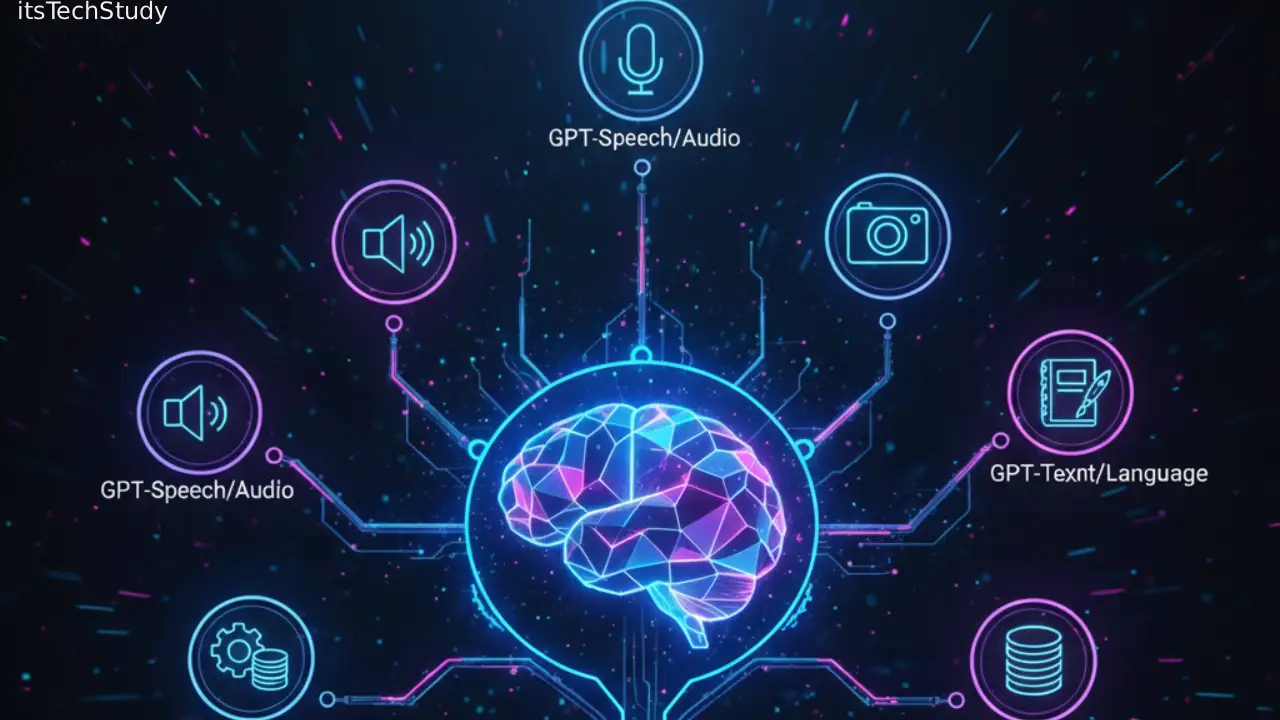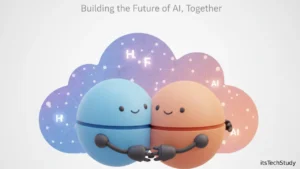Introduction: The AI Revolution and the Rise of GPT Models
Artificial Intelligence (AI) has redefined how humans interact with technology. From writing content and coding assistance to customer support and creative storytelling, AI has seamlessly integrated into nearly every digital experience we encounter today. At the center of this transformation stands the GPT (Generative Pre-trained Transformer) model – an innovation that has reshaped natural language processing (NLP) and machine learning.
When OpenAI first introduced GPT-1, it was a promising experiment. Fast forward to GPT-5.1, and we now see an AI model capable of reasoning, coding, generating natural dialogue, and even understanding visual data. However, as these models evolved, many tech enthusiasts and professionals found themselves asking:
What are the different types of GPT models?
How do they differ in architecture, capability, and use case?
Which version is best for my needs – GPT-3, GPT-4, or GPT-5.1?
This article breaks down each type of GPT model, its unique characteristics, and how to use it effectively. Whether you’re a developer, researcher, or tech entrepreneur, understanding these models can help you leverage AI to its fullest potential.
What Are GPT Models? A Quick Overview
GPT stands for Generative Pre-trained Transformer, a class of AI models designed to understand and generate human-like text. Built upon the transformer architecture developed by Google in 2017, GPT models use massive datasets and advanced neural networks to learn grammar, facts, and context.
In simpler terms, GPT models are language prediction systems. They predict the next word in a sentence based on previous words – but at scale, this prediction becomes creativity, comprehension, and conversation.
Core Components of GPT Models
- Transformer Architecture – Enables parallel processing and contextual understanding.
- Pre-training and Fine-tuning – Pre-trained on large datasets, then fine-tuned for specific applications.
- Tokens and Attention Mechanisms – GPT models divide text into tokens and use attention layers to determine context.
Evolution of GPT Models: From GPT-1 to GPT-5.1
The GPT family has evolved rapidly, with each generation improving upon its predecessor in scale, efficiency, and intelligence.
Table: Comparison of GPT Models (GPT-1 to GPT-5.1)
| Version | Release Year | Parameters | Key Features | Primary Use |
|---|---|---|---|---|
| GPT-1 | 2018 | 117M | Proof of concept for transformer-based NLP | Academic research |
| GPT-2 | 2019 | 1.5B | Fluent text generation, multi-domain tasks | Text generation & chatbots |
| GPT-3 | 2020 | 175B | Massive scale, few-shot learning | Content creation, coding |
| GPT-4 | 2023 | ~1T (estimated) | Multimodal capabilities (text + images) | Advanced chatbots, research |
| GPT-5.1 | 2025 | Confidential | Contextual memory, reasoning, multimodal intelligence | Enterprise AI, development tools, automation |
Understanding Each Type of GPT Model
1. GPT-1: The Foundational Model
GPT-1 was the proof that transformer-based architectures could outperform traditional NLP methods. It introduced the idea of pre-training a model on large text corpora and fine-tuning it for specific tasks.
Use Cases:
- Academic experiments
- Simple language generation
- Baseline NLP models
Pros:
- Efficient for its time
- Introduced pre-training + fine-tuning concepts
Cons:
- Limited language fluency
- Poor contextual understanding
2. GPT-2: The Turning Point
When GPT-2 launched, it made headlines for its ability to generate coherent and surprisingly creative text. OpenAI initially restricted its release due to concerns about misuse, a testament to its power.
Key Features:
- 1.5 billion parameters
- Handles multiple domains without fine-tuning
- Excellent for summarization and text completion
Real-World Uses:
- Content creation tools
- Text summarizers
- Chatbots and dialogue systems
Pros:
- Generates fluent and creative outputs
- Robust for multiple tasks
Cons:
- Sometimes produces inaccurate or biased text
- Limited contextual reasoning
3. GPT-3: The Game Changer
GPT-3 transformed the AI landscape by introducing few-shot and zero-shot learning, meaning it could perform tasks with little or no specific training examples. With 175 billion parameters, it’s one of the largest language models ever created.
Applications of GPT-3:
- Copywriting and blog generation
- Coding assistants like GitHub Copilot
- Chatbots for customer engagement
- Data-to-text generation
Pros:
- Highly versatile and creative
- Strong few-shot learning capabilities
Cons:
- Computationally expensive
- May still “hallucinate” incorrect facts
4. GPT-4: The Multimodal Marvel
GPT-4 pushed boundaries by introducing multimodal learning — the ability to understand and process not just text, but also images and potentially video. It’s a massive step toward human-like reasoning and understanding.
Notable Upgrades:
- Enhanced contextual reasoning
- Support for multiple languages
- Handles images and structured data
Popular Uses:
- Visual question-answering
- Advanced virtual assistants
- AI tutoring systems
Pros:
- More accurate and reliable than GPT-3
- Improved safety and content moderation
Cons:
- Still limited by closed-source model
- Requires significant resources for fine-tuning
5. GPT-5.1: The Next-Generation Intelligence
The most advanced model yet, GPT-5.1, represents the evolution of AI into reasoning, memory retention, and real-time adaptability. It combines text, images, code, and even logical decision-making — making it a near-general AI system.
Core Strengths:
- Enhanced contextual memory
- Real-time reasoning and adaptive responses
- Integration with APIs, databases, and voice input
- Highly efficient and scalable for enterprise use
Applications of GPT-5.1:
- Personalized AI assistants
- Intelligent business analytics
- Software development automation
- Advanced research simulation
Pros:
- Deep reasoning and multimodal support
- Understands complex, multi-step queries
- Better accuracy and reduced hallucination rate
Cons:
- High infrastructure cost
- Limited public access
Key Differences Between GPT Versions
| Feature | GPT-2 | GPT-3 | GPT-4 | GPT-5.1 |
|---|---|---|---|---|
| Parameters | 1.5B | 175B | ~1T | Confidential |
| Input Type | Text | Text | Text + Image | Multimodal (Text, Image, Audio) |
| Learning Type | Fine-tuned | Few-shot | Multimodal | Adaptive reasoning |
| Speed | Medium | Fast | Faster | Ultra-fast |
| Availability | Open source | API | API | Enterprise/API |
How To Choose the Right GPT Model for Your Needs
Selecting the correct GPT model depends on your project’s goals, resources, and complexity.
For Developers
- Start with GPT-3 or GPT-4 if you want flexible APIs.
- Use GPT-5.1 for enterprise-grade integrations or autonomous systems.
For Content Creators
- GPT-3 is ideal for writing and editing.
- GPT-4 or GPT-5.1 is better for factually accurate, long-form content.
For Businesses
- GPT-5.1 offers custom AI agents, automation tools, and advanced analytics.
Pros and Cons of Using GPT Models
Pros
- Exceptional language fluency
- Rapid content generation
- Scalable and customizable
- Reduces development time
- Supports automation and research
Cons
- Can produce factual errors
- Requires high computational power
- Potential bias in training data
- Limited transparency in closed models
Practical Applications of GPT Models
GPT models are now embedded across industries. Here’s where they shine:
1. Content and Marketing
- Blog writing, social media content, and ad copy generation
- Product descriptions and SEO optimization
2. Programming and Development
- Code completion, debugging, and automation
- Intelligent IDE integrations
3. Customer Support
- AI-driven chatbots providing 24/7 responses
- Personalized user experience
4. Research and Data Analysis
- Generating summaries from research papers
- Pattern recognition and knowledge extraction
5. Education and Training
- AI tutors and learning companions
- Automated grading systems
Future of GPT Models: What’s Next?
The next phase of GPT models will likely focus on ethical AI, sustainability, and contextual intelligence. As GPT-5.1 evolves, we may see AI systems that can think, remember, and act autonomously – bridging the gap between narrow AI and true general intelligence.
However, as capabilities expand, so must regulations and ethical frameworks to ensure responsible use.
Conclusion: Mastering the GPT Evolution
Understanding the different types of GPT models – from GPT-1’s foundation to GPT-5.1’s advanced intelligence – gives you a front-row seat to the AI revolution. Each version has built upon its predecessor, moving from simple text generation to reasoning, adaptability, and multimodal understanding.
For developers, content creators, and businesses alike, knowing which model to use can mean the difference between ordinary performance and groundbreaking innovation. As we move into an era where AI models like GPT-5.1 redefine communication and creativity, one thing is certain – the journey of GPT is far from over.
Frequently Asked Questions (FAQ)
Q1: What does GPT stand for?
Ans: GPT stands for Generative Pre-trained Transformer, a type of deep learning model that understands and generates human-like text.
Q2: What makes GPT-5.1 different from previous models?
Ans: GPT-5.1 features contextual memory, multimodal reasoning, and real-time adaptability, making it far more capable than earlier models.
Q3: Can I train my own GPT model?
Ans: Yes, though training a large model like GPT-3 or GPT-4 requires massive resources. You can fine-tune smaller open-source models using frameworks like Hugging Face or LangChain.
Q4: Which GPT model is best for beginners?
Ans: GPT-3 is the best balance between power and accessibility, offering APIs that are easy to integrate into apps.
Q5: Is GPT-5.1 available for public use?
Ans: As of now, GPT-5.1 is primarily available through enterprise-level access, but limited developer APIs are expected soon.
Q6: Are GPT models safe to use?
Ans: OpenAI has introduced safety filters and content moderation in GPT-4 and GPT-5.1 to minimize bias and misinformation. However, users should still verify AI-generated content.












No Comments Yet
Be the first to share your thoughts.
Leave a Comment